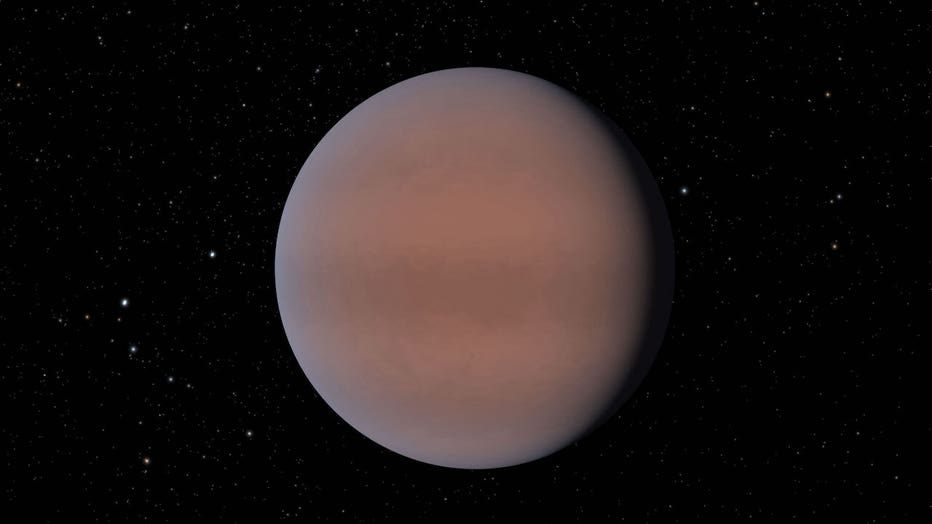Water vapor detected on a 'super Neptune' planet
WASHINGTON - Scientists have discovered water vapor in the atmosphere of a recently discovered planet, NASA announced Thursday.
According to the agency, the planet, named TOI-674 b, is a bit bigger than Neptune and orbits a red-dwarf star about 150 light-years away — which is considered nearby in astronomical terms.
TOI-674 b is considered an exoplanet, or a planet around other stars, known to have water vapor in their atmospheres.
The water vapor was discovered by an international team of scientists, led by Jonathan Brande of the University of Kansas, and included researchers from the NASA Ames Research Center and from IPAC and other research centers at Caltech. The discovery has been submitted to an academic journal.

Illustration of a "super Neptune," TOI-674 b, with an atmosphere that, according to a recent study, includes water vapor. Image credit: NASA/JPL-Caltech
The discovery grew from a partnership between the Hubble Space Telescope and TESS, NASA’s Transiting Exoplanet Survey Satellite, launched in 2018. The planet was first found by TESS, then its light spectrum was measured by Hubble.
Data from the now-retired Spitzer Space Telescope also helped astronomers tease out some of the planet’s atmospheric components.
Many questions remain, such as how much water vapor its atmosphere holds, but researchers say the planet’s atmosphere is far easier to observe than those of many exoplanets, making it a prime target for deeper investigation.
"The planet’s distance, size and relationship to its star make it especially accessible to spaceborne telescopes," NASA wrote in a press release. "As the comparatively large planet – in a size-class known as "super Neptune" – crosses the face of its smallish star, starlight shining through its atmosphere can be more easily analyzed by our telescopes."
RELATED: Massive asteroid will fly by Earth next week, NASA data shows
NASA said only three other Neptune-sized exoplanets have had aspects of their atmospheres revealed so far, though the advent of telescopes like Webb promises a golden age in the study of exoplanet atmospheres.
But, this is not the first time water vapor has been found on an exoplanet. In 2019, NASA’s Hubble telescope found water vapor on an exoplanet called K2-18B.
A study showed the planet was in a "habitable zone" around its star, a sign that "it’s possible for the planet to host liquid water at habitable conditions beneath its hydrogen-rich atmosphere," according to a statement from the University of Cambridge.
"The thermodynamic conditions at the surface of the H2O layer range from the supercritical to liquid phases, with a range of solutions allowing for habitable conditions on K2-18b," the researchers wrote in the study's abstract. "Our results demonstrate that the potential for habitable conditions is not necessarily restricted to Earth-like rocky exoplanets."
RELATED: NASA’s Perseverance rover makes ‘unexpected’ discovery about volcanic lava on red planet
Researchers were quick to caution, however, that because it's located in the habitable zone does not necessarily mean life exists.
"Water vapor has been detected in the atmospheres of a number of exoplanets but, even if the planet is in the habitable zone, that doesn’t necessarily mean there are habitable conditions on the surface," the study’s lead author Nikku Madhusudhan added in the statement. "To establish the prospects for habitability, it is important to obtain a unified understanding of the interior and atmospheric conditions on the planet — in particular, whether liquid water can exist beneath the atmosphere."
The study was published in The Astrophysical Journal Letters.
More than 4,000 exoplanets have been discovered by NASA in total, approximately 50 of which were believed to be potentially habitable as of September 2018. This means, they have the right size and the right orbit of their star to support surface water and, at least theoretically, to support life.
FOX News contributed to this story.


